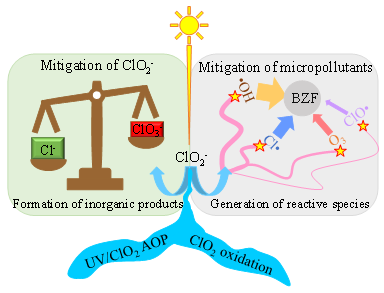
Juan Li from ADIIEE and Tao Yang from Wuyi University (Jiangmen, China) recently published one research paper entitled “Photolysis of chlorite by solar light: An overlooked mitigation pathway for chlorite and micropollutants” in the journal of Water Research.

Graphic abstract of the article
Chlorite (ClO2-) is an undesirable toxic byproduct commonly produced in the chlorine dioxide and ultraviolet/chlorine dioxide oxidation processes. Various methods have been developed to remove ClO2- but require additional chemicals or energy input. In this study, the authors proposed an overlooked mitigation pathway of ClO2- by solar light photolysis with a bonus for simultaneous removal of micropollutant co-present. ClO2- could be efficiently decomposed to chloride (Cl-) and chlorate by simulated solar light (SSL) at water-relevant pHs with Cl- yield up to 65% at neutral pH. Multiple reactive species including hydroxyl radical (•OH), ozone (O3), chloride radical (Cl•), and chlorine oxide radical (ClO•) were generated at neutral pH under investigated condition. Bezafibrate (BZF) as well as the selected six other micropollutants was efficiently degraded by the SSL/ClO2- system with pseudo-first-order rate constants ranging from 0.057 to 0.21 min-1 at pH 7.0, while most of them were negligibly degraded by SSL or ClO2- treatment alone. Kinetic modeling of BZF degradation by SSL/ClO2- suggested that •OH contributed the most, followed by Cl•, O3, and ClO•. The presence of water background components exhibited negative effects on BZF degradation by the SSL/ClO2- system, mainly due to their competitive scavenging of reactive species therein. The mitigation of ClO2- and BZF under photolysis by natural solar light or in realistic waters was also confirmed.
This study discovered an overlooked mitigation pathway for ClO2- and micropollutants, which has significant implications for understanding their fate in natural environments.
Dr. Juan LI working in the Advanced Interdisciplinary Institute of Environment and Ecology (ADIIEE), Beijing Normal University, China, is the corresponding author. Dr. Tao Yang working in the School of Biotechnology and Health Science, Wuyi University, China, is the first author of the paper. The research is mainly supported by the National Natural Science Foundation of China (52100013, 52200002), Natural Science Foundation of Guangdong Province (2022A1515011207), Guangdong Provincial Department of Education Youth Innovation Talents Project (Natural Science) (2020KQNCX092), Open Project of State Key Laboratory of Urban Water Resource and Environment, Harbin Institute of Technology (No. ES202222), the Research Project of High-level Talents of Wuyi University (2019AL024), and the Young Talent Project of Beijing Normal University (310432101).
Full Link of the paper: https://www.sciencedirect.com/science/article/abs/pii/S0043135423002440


